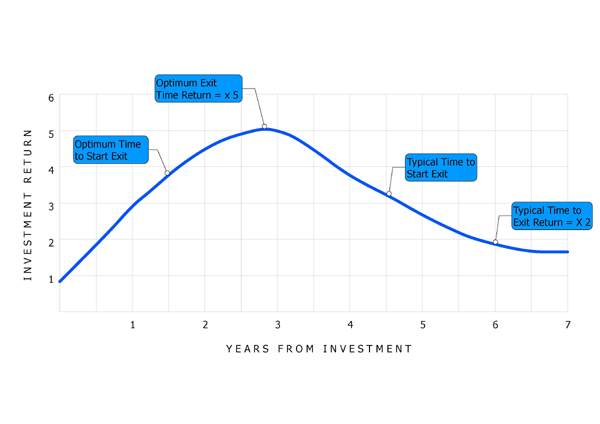Timing is Critical
Most business owners wait far too long before they start thinking about their exit and, as a consequence, they can lose a large slice of their investment. They listen to and believe the ‘folklore’ surrounding “Valuations” within this industry, which focuses purely on profit, EBITDA and revenue multiples.
As a result, they ride their business up and over the top and very often sell their companies for much less than could have been achieved; they lose the benefit of the valuation curve and lose the maximum return to their shareholders in the process.
The majority of companies in this sector sit back complacently, taking comfort from the fact that they occasionally have enquiries from potential buyers and, as a result of this passivity, end up exiting too late. This not only, adversely affects their shareholders’ ROI but also, their employees, who can often stagnate within a company that has reached a growth ceiling and is unable or unwilling to invest further - and thus stifles its own growth and that of its employees too.
‘Hot’ Sectors Attract Higher Valuations but also Greater Competition
It is a ‘given’ that, whenever a technology space becomes ‘hot’, the amount of money invested into companies in that space, by VC’s, will increase. This could have both positive and negative consequences for an established company. More money coming into a sector could make it very tough to compete as their VC-backed competitors will have more money to throw at their marketing and sales efforts. Greater numbers of competitors may also, suddenly emerge, which often compels organisations to seek additional capital in order to compete. On the positive side, a good flow of money into a sector will also increase valuations. This is currently the situation in a number of sub-sectors within the software tech sector.

However - and here is the big, big ‘BUT’ - it takes 6 to 18 months from making the decision to sell a company to completing the sale. This means that, in order to achieve your best exit at maximum valuation, the decision to sell has to be made 6 to 18 months before the sale price peaks. Delaying any longer than that, typically results in decreasing returns as the valuations hit the downward slope of the bell curve.
Valuations are Comprised of Many Elements
The sale price you will achieve when selling a company depends on a significant number of factors. IT WILL NEVER DEPEND SOLELY ON MULTIPLES OF PROFIT OR REVENUE - or any other, purely financial, ‘mythical’ formula. To state otherwise is bunkum and should be disregarded at all costs.
There are so many factors - both external and internal - that affect valuations. It is always important to consider the general market economy. However, possibly of even greater importance in the software tech sector, is the “micro-market” within your particular sub-sector. This will substantially affect your valuation and the timing of your sale. Most CEO’s are so busy managing their business that they struggle to keep up with the macro economy, let alone the micro economy, of their particular market. You must be ahead of the curve. If you wait and watch several years of acquisitions filtering through before making your move, you will undoubtedly be lagging too far behind to even consider entering the race.
Micro Economies Affect Valuations by a Factor of 3 or More
The micro economy can affect the valuation of your business by at least a factor of three and sometimes considerably more - as we are currently seeing in niche areas.
It is hardly surprising that most CEO’s ride their business up the steep growth curve of valuations and then straight over the top. Trade buyers and investors want to acquire when they can forecast a healthy and profitable growth, not when the growth is already historic. It is essential you benefit from correct timing when selling a business; if a space becomes ‘hot’, then supply and demand will significantly affect valuations - with prices increasing, sometimes several times within a few months. Surprisingly, these micro market ‘climate’ changes often affect price far more than the fundamentals of the company.
Plan Your Exit Strategy in Advance
Getting your exit strategy right is a hugely under-rated element of business planning and is often under-exploited as part of an overall, synergistic business strategy. Sometimes, a company will need to change direction and reposition themselves in order to create additional value for their exit. Most senior executives simply miss their optimum valuation by missing their exit window because they have not taken the time to create an exit strategy plan for their business. To be candid, frank, many CEO’s have not been part of more than two business exits and just do not have the knowledge, expertise, experience and focus – or the time - to successfully execute this last, most important step.
When Times are Good, Stop & Plan Your Exit
When the executives and the Board are achieving good growth and profit, they are all having fun and this is not typically, the time they start to think about their exit; they want to keep riding the business hard. However, this is probably the best time to stop and take stock, rather than when growth slows and things start to get tougher.
So, in order to avoid riding your business up and over the top, plan your exit strategy early and make sure that you are in alignment with the macro and micro dynamics of your specific market. If you do this, you will cross the finishing line ahead of the rest of the field.
About Mark Edwards, CEO, Boss Equity







